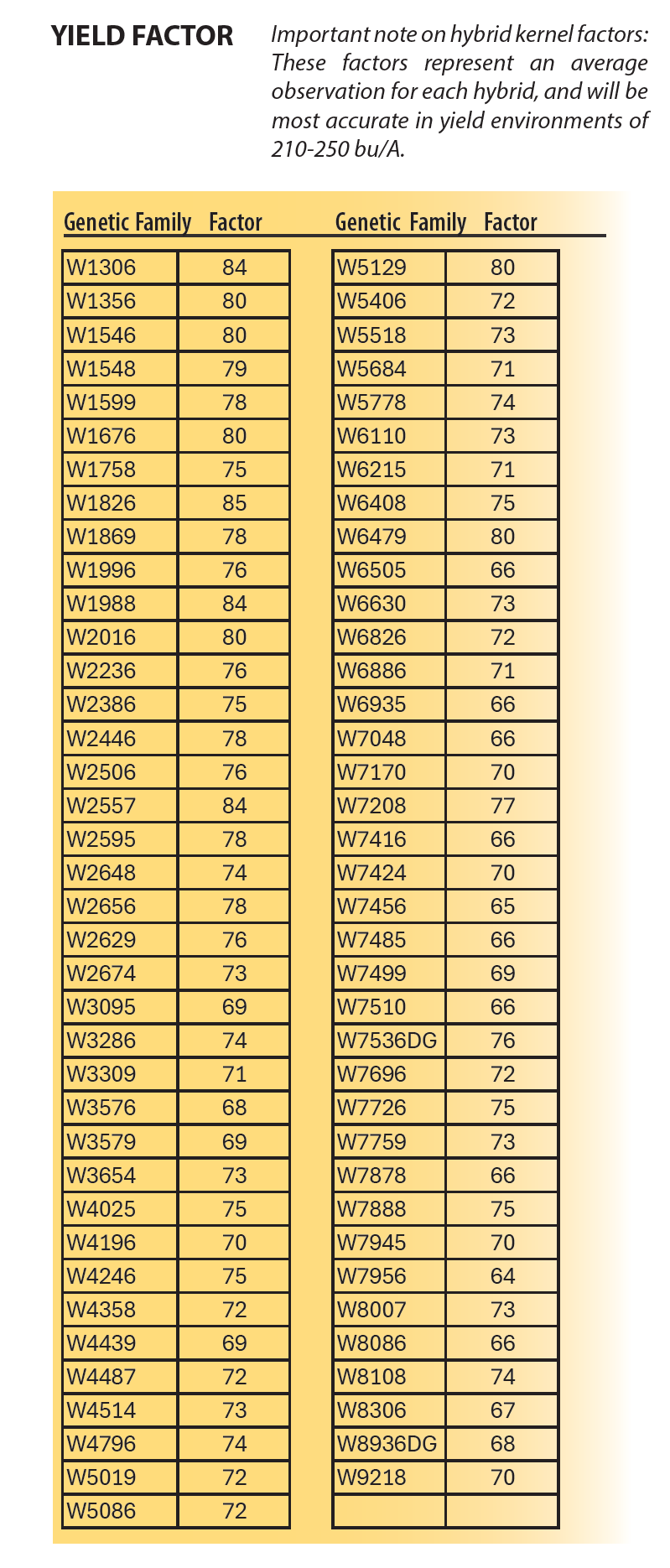Performing Yield Estimates
In late summer and early fall, many corn growers evaluate fields and make yield estimates either for storage or marketing purposes. Estimating yield can be difficult since weather conditions can result in highly variable yield differences within a field. To improve accuracy of yield estimates, multiple samples need to be taken throughout a field.
Estimate on a whole field basis
When conducting whole field yield estimates, the Yield Component Method is commonly used and is calculated by:

This yield estimate is best done at least 3 weeks after pollination when kernels are in the milk stage (R3) and beyond.
Kernels per bushel
The number of kernels required to make a bushel can be highly variable among hybrids and growing conditions. Typically, 90,000 kernels per bushel is used as an average, though hybrid differences are known to vary by over 30%.
Each year Wyffels research calculates the number of kernels per bushel (kpb) for each genetic family (see table on page 2). This factor will vary based on the growing conditions each year. For instance, kernel size tends to be smaller in lower yield environments which increases the kpb factor. Conversely, kernel size is typically larger in higher yield environments due to ideal conditions during grainfill, thus the kpb factor is smaller.
Although the exact number of kernels per bushel for each hybrid will vary each year based on crop conditions, the relative differences between hybrids will remain fairly consistent. So, even in more variable conditions the listed kernel per bushel factors will serve as a great tool to see differences between hybrids when performing yield estimates.
Yield Estimate Protocol
Use the following protocol to ensure more accurate estimates.
Ear Counts
- Measure 1/1000th of an acre in one row (17’5” for 30- inch rows) and count the number of harvestable ears present. Do not rely on planting population as not all seeds likely emerged and every plant might not have an ear.
- Take several ear counts across the field to represent all the conditions present. Don’t just hit the garden spots. In fields impacted by heat and drought or that have reduced stands, ten or more samples will be needed to ensure reasonable representation of the entire field.
Kernel Counts
- Collect 3 to 5 ears in each harvestable ear count.
- Collect every 7th ear to get an unbiased, representative sample.
- Count and multiply the number of kernel rows around by the number of kernels in a row for each ear. For example: 16 kernel rows around x 34 kernels per row = 544 kernels/ear.
- Average the kernel counts across the ear samples.
Calculate Yield
- Plug in the harvestable ears per acre and kernels per ear into the above formula
- Plug in the kernel per bushel factor for listed hybrids. If the hybrid is not listed, use 90,000 kpb for average sized kernels, 110,000 kpb if kernels are small, and 70,000 kpb for large kernels.
Wyffels Yield Calculator
In order to make yield estimates easier and more efficient, Wyffels has developed an online yield calculator. The Wyffels Yield Calculator can be found on the Wyffels.com website under the Agronomy tab. This calculator has been pre-programmed with all of the specific hybrid factors for hybrids in the Wyffels lineup. There is also a yield environment option to account for kernel size variability. To use the calculator, click this link.

Summary
No matter how detailed you are with this process, remember that you are performing an estimate. To improve accuracy, increase your sample number throughout the field. Using the kernels per bushel factor for each hybrid will help fine tune estimates for your Wyffels products. And using the online Wyffels Yield Calculator will help reduce mathematical error.
